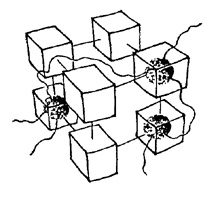copyright 1994 Tamiko Thiel
Chapter IV. The machine takes form
The inspiration for the design, I believed, should come from the
ideas of the computer scientists who were developing the CM-2.
Danny Hillis, but also Brewster Kahle and Carl Feynman, with whom I
shared an office, were all filled with a passionate and infectious
enthusiasm for the machine. They talked of the machine as a
cerebral starship, a vehicle that could open up boundless new
frontiers, or as an immensely complex, constantly fluctuating
electronic society -- the image of an electronic brain.
Their visions of the machine evoked in my mind the sculptures of
the Italian artist
Arnaldo Pomodoro. His simple, smoothly polished
geometric forms cut into or eroded away by deep surface incisions
have always suggested strange planets or massive starships to me.
Beneath the smooth and the serrated surfaces of his sculptures
there seemed to be room for entire worlds, high-technology
cultures, long-dead civilizations. His work communicated a sense of
immense, seething complexity beneath the surface of a geometric,
man-made object.
These were the feelings and images I wanted to capture in the
physical form of the CM-2. Aware of the incestuous nature of our
relationship to the Connection Machine, we looked for help from
impartial, experienced outside viewers as well. The industrial
designers Allen Hawthorne and Gordon Bruce, who had had many years
of experience designing computer products for IBM, agreed to help
us with the detailed design of the machine. Additionally, to make
sure we hadn't blinded ourselves to any possibilities, I asked the
architect Tom Chytrowsky to spend some time helping me experiment
with pure form, brainstorming whatever possible and impossible
shapes the machine could take.
But if form should follow function, and function in a computer
means the workings of the invisible processors hidden in the
silicon chips, then the real function of the CM-2 lay in the way
the processors communicated with each other, in the structure of
the 12-D hypercube network. Hawthorne and Bruce were themselves
convinced from the beginning that the cube-of-cubes was the right
shape for the machine: the large cube built up out of 8 smaller
cubes, which I had developed as a visual symbol of the CM-2 for
internal use at Thinking Machines.
This symbol has been widely published on the Thinking Machines T-
shirt worn by Richard Feynman on the cover of his popular book
"What Do You Care What Other People Think?" and then made famous when as the "Feynman t-shirt" in the 1990s, when Apple's "Think different" campaign used a photo of him wearing the
CM-1 t-shirt.
(See Thunkos photo shoot!)
The graphic of a 3-D
hypercube represents the "hard" electrical connections of part of
the 12-D network, but inside these hard rectangular boxes are the
"fuzzy" software connections that can be changed independently of
the physical wires and traces. |

CM-1 t-shirt design |
The hard physical wiring and the soft programmable connections were
equally important aspects of the structure of the machine. How
could we make something as abstract as a program -- with the
intangibility of a speech or a conversation -- visible to the eye?
Carl Feynman had described a fantasy of the CM-2 as a vast cloud of
lights that flickered as they sent their electronic messages back
and forth, like the firing of neurons in a brain. Status lights are
commonly installed on printed circuit boards to provide visual
monitors of the current state of components -- indicating whether
power is "on," or a chip is plugged in properly. Why not use these
to make the intangible and unseen activity of the processors
visible on the outside of the machine?
Thus, we chose to depict the hardware structure of the machine in
the external form of the CM-2 package, and depicted the software
connections within this hardware structure using the status lights
of the chips: eight cubes, each holding 9 dimensions of the
hypercube, are visually plugged together to form the cube-of-cubes,
just as the internal electronic components are physically plugged
together to form the highest level of the machine, the 12-D
hypercube. Through the skin of the machine glow the lights from
4,096 chips, flickering on and off as the processors work in
parallel, each one computing its own part of the data. The
microscopic elements of the machine, as well as those buried in the
confusion of traces and cables, thus become visible and let the
machine speak for itself. (click for b/w image)
This would communicate to the viewer the immense complexity hidden
beneath the surface of the machine. A massive electronic brain, 1.5
meters in height, it is connected with cables to the data drives
that feed its processors information and to the workstations and
monitors through which it communicates with its human users. A
hard, geometric object, black (the non-color of sheer, static
mass), it is filled with a soft, constantly changing cloud of
lights, red (the color of life and energy). This would be a way to
ornament without decorating, to express a symbolic aspect of the
machine using raw form, size and proportion, color and material.
(click for color image)
(previous)
(next)
